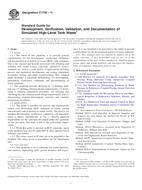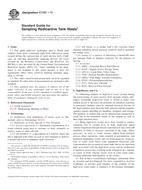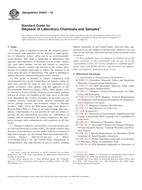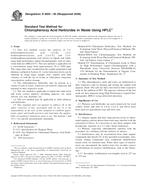Potřebujeme váš souhlas k využití jednotlivých dat, aby se vám mimo jiné mohly ukazovat informace týkající se vašich zájmů. Souhlas udělíte kliknutím na tlačítko „OK“.
ASTM C1571-03(2012)
Standard Guide for Characterization of Radioactive and/or Hazardous Wastes for Thermal Treatment (Withdrawn 2018)
Automaticky přeložený název:
Standardní Příručka pro charakterizaci radioaktivního a / nebo nebezpečných odpadů na tepelné zpracování
NORMA vydána dne 1.1.2012
Informace o normě:
Označení normy: ASTM C1571-03(2012)
Poznámka: NEPLATNÁ
Datum vydání normy: 1.1.2012
Kód zboží: NS-11882
Počet stran: 18
Přibližná hmotnost: 54 g (0.12 liber)
Země: Americká technická norma
Kategorie: Technické normy ASTM
Kategorie - podobné normy:
Anotace textu normy ASTM C1571-03(2012) :
Keywords:
accuracy assessment, mass balance, thermal treatment, waste analyses, Accuracy assessment, Chemical properties/characteristics, Hazardous waste materials, Mass balance, Physical properties/dimensions/characteristics, Radioactive waste materials, Thermal treatment, Waste materials/processing/analysis, ICS Number Code 13.030.30 (Special wastes)
Doplňující informace
| Significance and Use | ||||||||||||||||||||||||||||||||||
|
This guide identifies methods to determine the physical and chemical characteristics of a variety of hazardous and/or radioactive wastes including heavy metal contaminated wastes. These wastes can be in the physical form of sludges (wet or dry), spent waste water filter aids, waste water filter cakes, incinerator ashes (wet or dry), incinerator blowdown (wet or dry), asbestos, resins, zeolites, soils, unset or unsatisfactory cementitious waste forms in need of remediation, lead paint wastes, radioactively or non-radioactively contaminated asbestos, geologic mill tailings (also known as byproduct materials) and other naturally occurring or accelerator produced radioactive materials (NORM and NARM), etc. and combinations of the above. This guide may not be applicable to piping, duct work, rubble, debris waste or wastes containing these components. This guide identifies the physical and chemical characteristics useful for developing high temperature thermal treatment methodologies for a variety of hazardous and/or radioactive process wastes and soils including heavy metal contaminated wastes. The waste characteristics can be used to (1) choose and develop the thermal treatment methodology, (2) determine if waste pretreatment is needed, (3) aid in development of thermal treatment process control, (4) develop surrogate waste formulations, (5) perform treatability studies, (6) determine processing regions (envelopes) of acceptable waste form composition, and/or (7) perform pilot scale testing with actual or surrogate waste, and/or (8) determine the composition and concentrations of off-gas species for regulatory compliance. This guide identifies applicable test methods that can be used to measure the desired characteristics of the hazardous and/or radioactive wastes described in 4.1. The analyses discussed in this standard can be performed by a variety of techniques depending on equipment availability. For example, Gas Chromatograph Mass Spectrometry (GC/MS) can be used to measure the amount and type of off-gas species present. However, this standard assumes that such sophisticated equipment is unavailable for radioactive or hazardous waste service due to potential contamination of the equipment. The analyses recommended are, therefore, the simplest and least costly analyses that can be performed and still considered adequate. Not every characteristic given in this guide is necessary for every waste (see Fig. 1). Cation analysis is necessary for every waste in order to determine whether the final waste form will be a homogeneous glass, a glass-ceramic, or a slag (see Appendix X1). Waste Analysis Method A is applicable when it is desired to know the amount and type of volatiles to be expected during thermal treatment and their compatibility with the thermal treatment and off-gas unit materials of construction and design capacity. These methods may be used to determine incinerator off-gas composition and concentrations. Waste analysis Method A is applicable when it is necessary to know the amount of organics in the waste independently of the amount of other volatile constituents present for safety concerns. These methods may be used to determine incinerator off-gas composition and concentrations. Waste analysis Method A is applicable when it is necessary to know if molten salt formation and accumulation in a thermal treatment unit in the presence of water vapor may be a safety concern. Waste Analysis Methods B and C are applicable when it is desired to only know the amount of volatiles to be expected during thermal treatment, for example, when speciation of the volatiles and potential molten salt formation is not of concern. These methods may be used to determine the total concentration of incinerator off-gases. Data from these tests may form part of the larger body of data that are necessary in the logical approach to development of high temperature treatment and/or pretreatment methodologies for a variety of hazardous and/or radioactive wastes as described in 4.1.
|
||||||||||||||||||||||||||||||||||
| 1. Scope | ||||||||||||||||||||||||||||||||||
|
1.1 This guide identifies methods to determine the physical and chemical characteristics of radioactive and/or hazardous wastes before a waste is processed at high temperatures, for example, vitrification into a homogeneous glass ,glass-ceramic, or ceramic waste form. This includes waste forms produced by ex-situ vitrification (ESV), in-situ vitrification (ISV), slagging, plasma-arc, hot-isostatic pressing (HIP) and/or cold-pressing and sintering technologies. Note that this guide does not specifically address high temperature waste treatment by incineration but several of the analyses described in this guide may be useful diagnostic methods to determine incinerator off-gas composition and concentrations. The characterization of the waste(s) recommended in this guide can be used to (1) choose and develop the appropriate thermal treatment methodology, (2) determine if waste pretreatment is needed prior to thermal treatment, (3) aid in development of thermal treatment process control, (4) develop surrogate waste formulations, (5) perform treatability studies, (6) determine processing regions (envelopes) of acceptable waste form composition, (7) perform pilot scale testing with actual or surrogate waste, and/or (8) determine the composition and concentrations of off-gas species for regulatory compliance. The analyses discussed in this standard can be performed by a variety of techniques depending on equipment availability. For example, Gas Chromatograph Mass Spectrometry (GC/MS) can be used to measure the amount and type of off-gas species present. However, this standard assumes that such sophisticated equipment is unavailable for radioactive or hazardous waste service due to potential contamination of the equipment. The analyses recommended are, therefore, the simplest and least costly analyses that can be performed and still be considered adequate 1.2 This guide is applicable to radioactive and/or hazardous wastes including but not limited to, high-level wastes, low-level wastes, transuranic (TRU) wastes, hazardous wastes, mixed (hazardous and radioactive) wastes, heavy metal contaminated wastes, and naturally occurring or accelerator produced radioactive material (NARM or NORM) wastes. These wastes can be in the physical form of wet sludges, dried sludges, spent waste water filter aids, waste water filter cakes, incinerator ashes (wet or dry), incinerator blowdown (wet or dry), wastewaters, asbestos, resins, zeolites, soils, unset or unsatisfactory cementitious wastes forms in need of remediation, lead paint wastes, etc. and combinations of the above. This guide may not be applicable to piping, duct work, rubble, debris waste or wastes containing these components. 1.3 This guide references applicable test methods that can be used to characterize hazardous wastes, radioactive wastes, and heavy metal contaminated process wastes, waste forms, NARM or NORM wastes, and soils. 1.4 These test methods must be performed in accordance with all quality assurance requirements for acceptance of the data. 1.5 This standard may involve hazardous materials, operations, and equipment. This standard does not purport to address all of the safety concerns, if any, associated with its use. It is the responsibility of the user of this standard to establish appropriate safety and health practices and determine the applicability of regulatory limitations prior to use. |
||||||||||||||||||||||||||||||||||
| 2. Referenced Documents | ||||||||||||||||||||||||||||||||||
|
Podobné normy:
Historická
1.6.2011
Historická
1.6.2011
Historická
15.11.2006
Historická
1.5.2010
Historická
1.2.2006
Historická
1.5.2014
Doporučujeme:
Aktualizace technických norem
Chcete mít jistotu, že používáte pouze platné technické normy?
Nabízíme Vám řešení, které Vám zajistí měsíční přehled o aktuálnosti norem, které používáte.
Chcete vědět více informací? Podívejte se na tuto stránku.



 ASTM C1750-11
ASTM C1750-11 ASTM C1751-11
ASTM C1751-11 ASTM D4447-10
ASTM D4447-10 ASTM D5608-10
ASTM D5608-10 ASTM D5659-95(2006)..
ASTM D5659-95(2006).. ASTM D5830-14
ASTM D5830-14
 Cookies
Cookies
